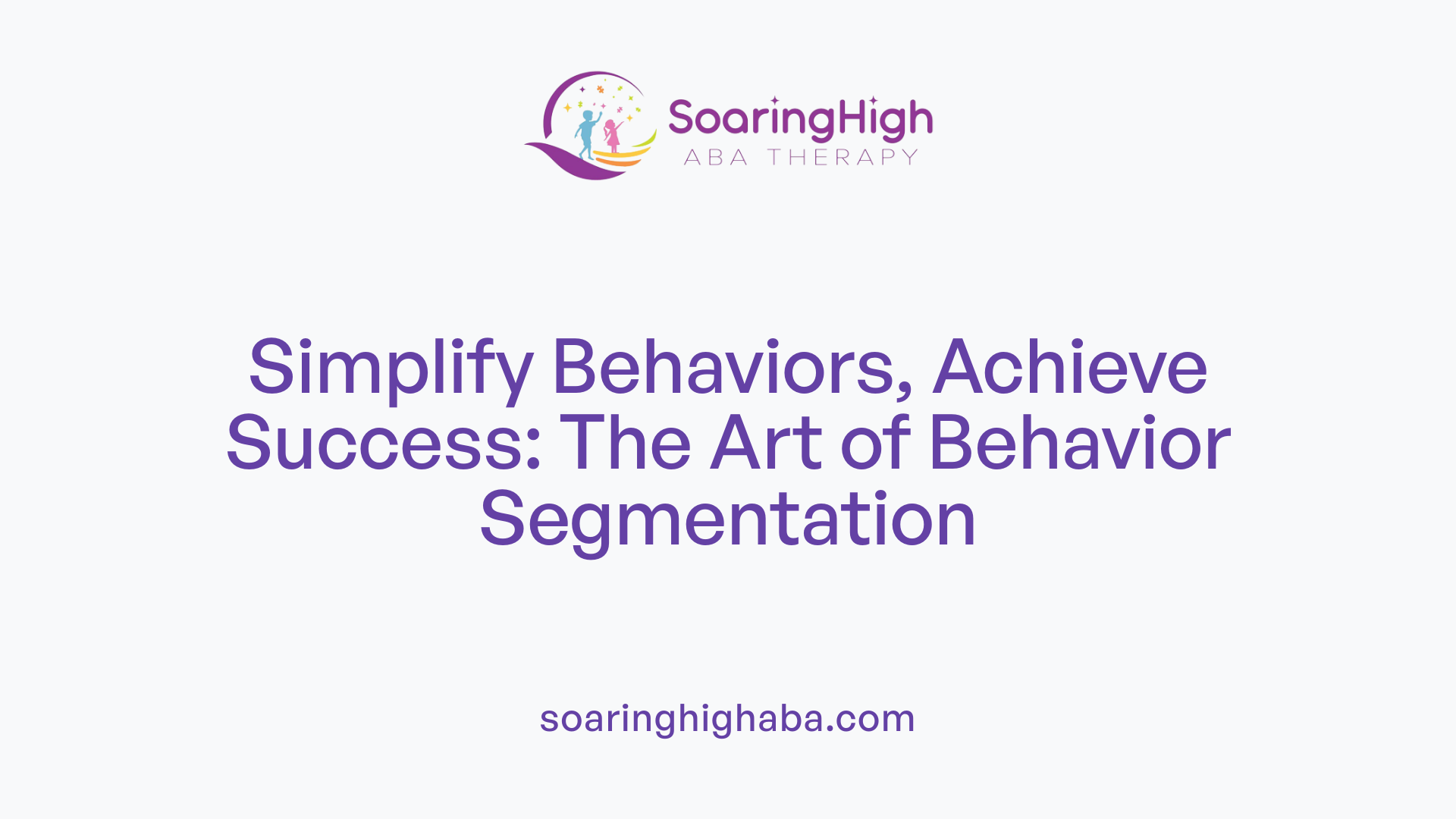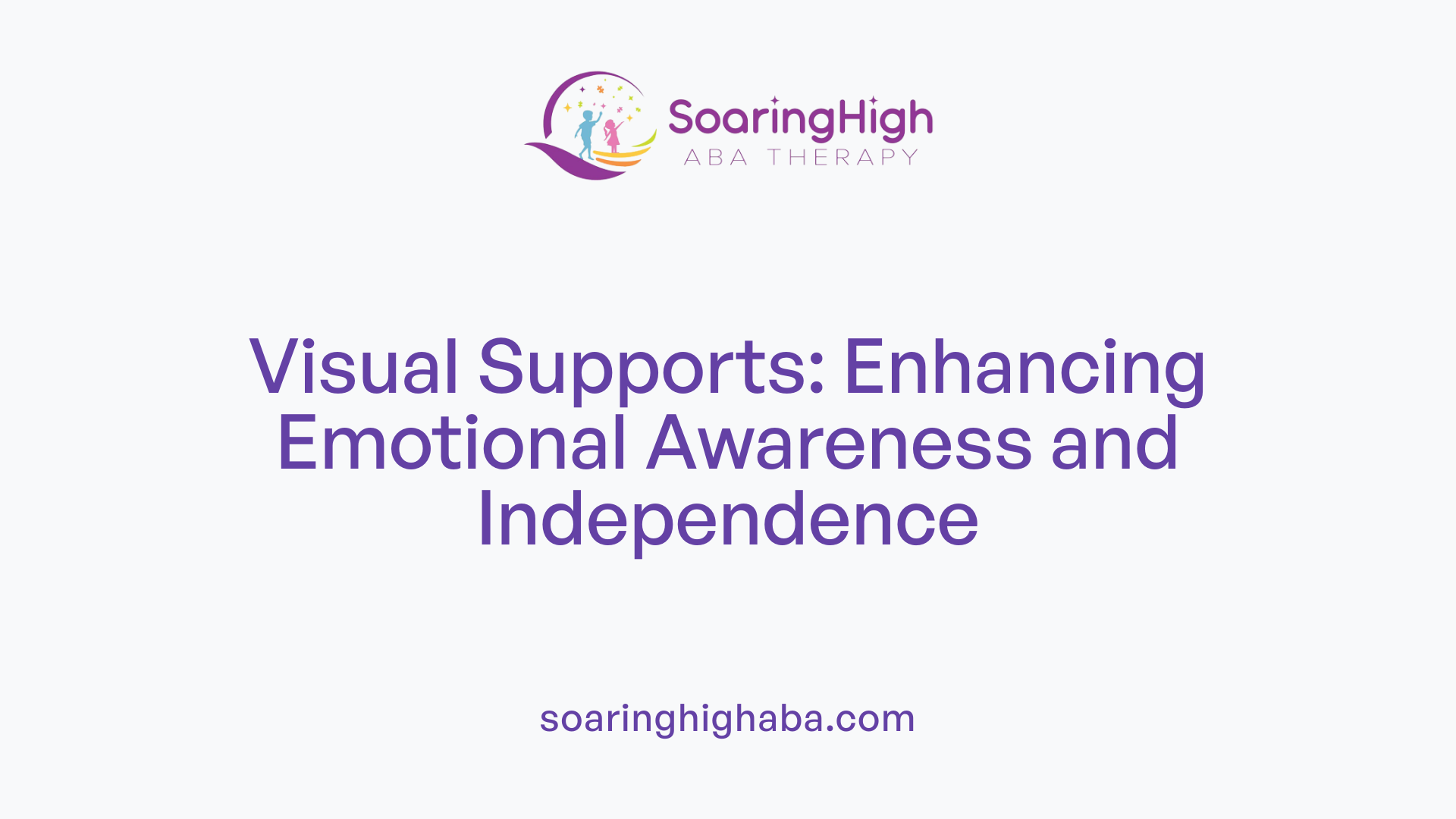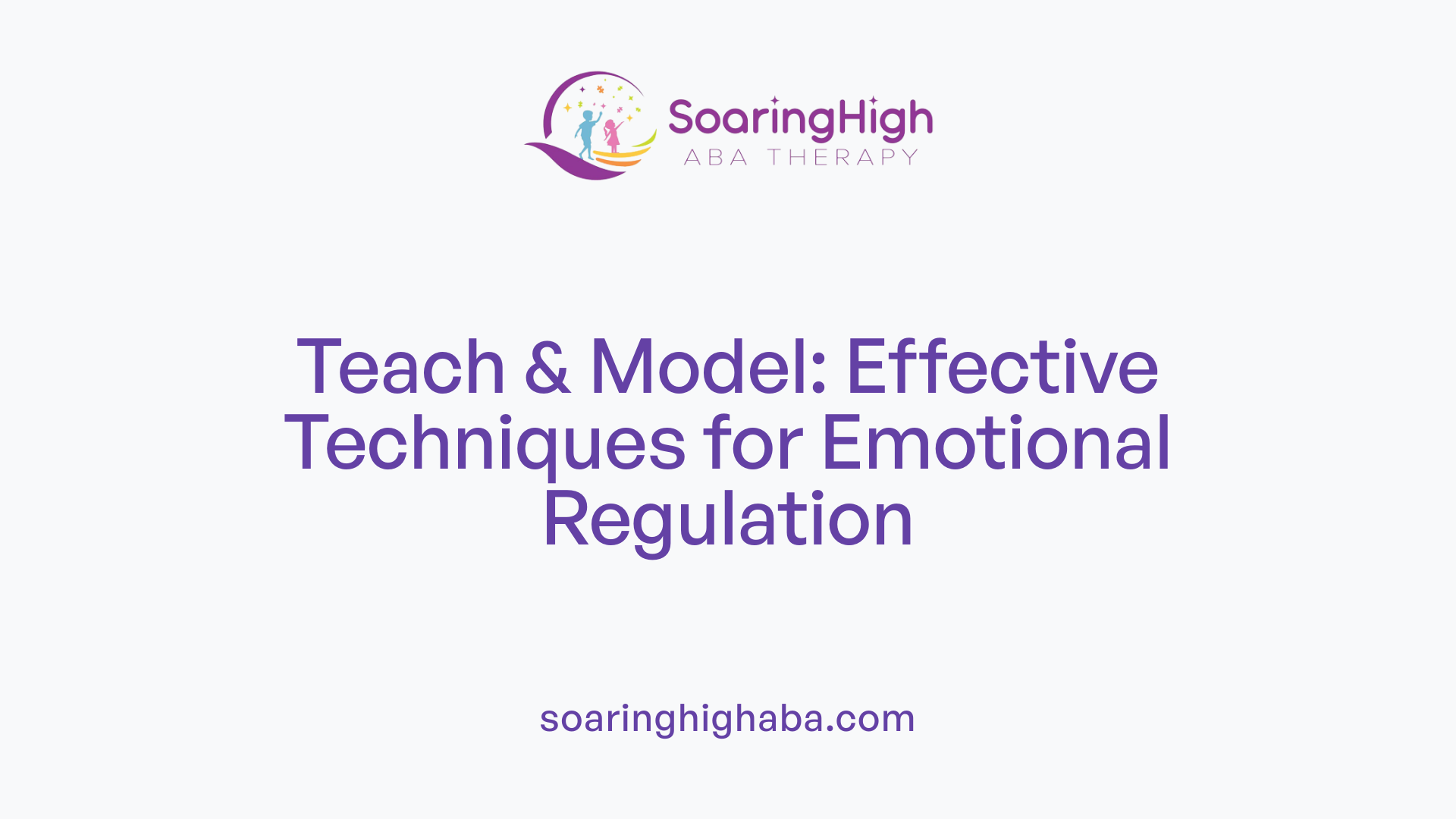Unlocking the Potential for Autonomy in Self-Regulation
Self-regulation is a vital skill that enables individuals, especially those with autism, to manage their emotions, behaviors, and reactions effectively. Applied Behavior Analysis (ABA) offers a structured, evidence-based approach to enhance these skills, fostering independence, improving daily functioning, and enriching overall quality of life. This article explores how ABA techniques can be systematically employed to teach, reinforce, and sustain self-regulation abilities across various settings.
Understanding Self-Regulation and Its Importance

What is self-regulation?
Self-regulation refers to the ability to manage emotions, behaviors, and reactions in various situations. It involves awareness of one’s feelings, thoughts, and actions, and the capacity to control impulsive responses or escalate emotions appropriately. Developing self-regulation skills allows individuals to stay calm, focused, and adaptable, especially in challenging or new environments.
Why is self-regulation important for individuals with autism?
For people with autism spectrum disorder (ASD), self-regulation is often more challenging due to sensory sensitivities, emotional difficulties, and communication barriers. Enhancing these skills helps reduce anxiety and disruptive behaviors, promoting better social interactions and learning experiences.
How does self-regulation impact daily life and independence?
Effective self-regulation supports greater independence by enabling individuals to handle transitions, control frustrations, and cope with overstimulation. These skills foster a more predictable daily routine, improve social relationships, and allow for success in educational and vocational settings. Ultimately, improved self-regulation contributes significantly to a higher quality of life.
What ABA therapy techniques can be used to improve self-regulation skills?
ABA therapy incorporates various methods to boost these skills. Techniques include teaching individuals to monitor their own behaviors through self-monitoring checklists or digital apps. Goal-setting exercises are broken into small, manageable steps, with progress tracked visually. Self-reinforcement, where individuals reward themselves for meeting targets, encourages consistent practice.
Social stories, developed by Carol Gray, are effective tools that explain appropriate responses and coping strategies in different situations, often using visual aids like the Hard Times Board. Relaxation activities such as deep breathing, visualization, and sensory integration exercises also help manage emotions and sensory overload.
Environmental modifications, like creating calming spaces or using visual schedules, prepare individuals for upcoming transitions and reduce triggers for challenging behaviors. Customizing these strategies to each person's specific needs ensures better outcomes and promotes greater independence.
Overall, systematic use of these ABA techniques supports children and adults with autism in developing essential self-regulation skills, leading to improved emotional control, social functioning, and daily independence.
Breaking Down Complex Behaviors for Effective Self-Regulation

What are the steps in behavior analysis?
In behavior analysis, especially within applied behavior analysis (ABA), the process begins with identifying the target behavior that needs improvement. This includes understanding the context, triggers, and consequences of the behavior. Next, the behavior is broken down into smaller, manageable parts—this is called behavior segmentation. Teachers and therapists then analyze these parts to develop effective intervention strategies.
Once behaviors are segmented, an intervention plan is crafted that uses systematic reinforcement to encourage desirable behaviors. This often involves setting clear goals, employing visual aids, and continuously monitoring progress. Adjustments are made based on ongoing assessments to ensure the behavior change is meaningful and sustainable.
How is behavior segmented into components?
Component behavior segmentation involves dividing complex, often multi-step behaviors into simpler, discrete actions. For example, if a child struggles with completing homework, the task can be broken into smaller steps: gathering materials, reading instructions, completing each problem, and checking work.
This segmentation allows for targeted teaching of each step, making it less overwhelming and easier to learn. Visual tools like checklists or task analysis charts can help learners understand what each part entails and monitor their progress.
Why is systematic reinforcement important?
After breaking down behaviors into parts, systematic reinforcement is used to encourage the correct execution of each component. Reinforcement must be consistent, immediate, and meaningful for the individual.
For example, providing praise, tokens, or other incentives when a learner completes a step correctly increases the likelihood that they will repeat the behavior. Over time, reinforcement can be faded, and learners are encouraged to self-reinforce, fostering independence.
Visual connection between teaching components
| Behavior Analysis Step | Behavior Segmentation | Reinforcement Strategy |
|---|---|---|
| Identify target behavior | Break into manageable parts | Prompt correct responses & reward |
| Observe & assess | Use visual aids to clarify steps | Systematic and consistent |
| Develop intervention plan | Use task analysis charts | Gradual fading of prompts |
| Monitor progress | Practice with role-play | Encourage self-monitoring and self-reward |
| Adjust strategies as needed | Reinforce independence | Foster long-term self-regulation |
What about the role of visual tools?
Visual aids, such as schedules, checklists, and social stories, support learners in understanding the components of behaviors and tracking their progress. These tools help individualize learning and provide clear expectations.
In summary, breaking behaviors into smaller parts through component segmentation makes complex skills approachable. Combining this with systematic reinforcement ensures that learners are motivated and supported throughout their journey toward self-regulation and independence.
Teaching Self-Management Skills with ABA
How can ABA techniques be tailored to support self-regulation in individuals with autism?
To support self-regulation in individuals with autism, ABA techniques must be personalized based on thorough assessments. These assessments help identify specific triggers, emotional cues, and preferred coping strategies unique to each person. Once these are understood, interventions can include visual supports such as emotion charts, social stories, and visual schedules that provide predictability and improve emotional awareness.
Teaching coping mechanisms like deep breathing, counting, and relaxation strategies through role-playing and modeling helps individuals learn effective ways to manage overwhelming emotions. Reinforcing these skills with positive feedback and reward systems encourages consistent practice across different environments.
Creating sensory-friendly spaces and using structured transition routines help reduce sensory overload and anxiety. Involving caregivers in ongoing training and reinforcement ensures these self-regulation strategies are applied consistently outside of therapy sessions, fostering greater independence.
By tailoring ABA practices to the individual’s needs and providing multiple opportunities for practice, practitioners can foster meaningful improvements in emotional regulation and self-control.
Fundamentals of Effective Goal-Setting and Monitoring
How can ABA techniques support the development of self-management skills?
Applied Behavior Analysis (ABA) employs systematic methods to teach individuals, particularly those on the autism spectrum, how to manage their own behaviors effectively. ABA techniques break down complex behaviors into manageable steps, making it easier for learners to master each component and gradually take control over their actions.
One of the crucial aspects of ABA-supported self-management is setting small, achievable goals that serve as stepping stones toward broader objectives. Breaking goals into manageable parts helps maintain motivation and prevents overwhelm.
Visual aids such as checklists, visual schedules, tokens, and progress charts play a significant role in tracking achievements and providing visual cues for expected behaviors. These tools make abstract concepts concrete, enabling learners to better understand their progress and what remains to be done.
Effective goal setting begins with establishing clear, measurable targets tailored to each individual's developmental level and needs. Regularly reviewing progress allows for goal adjustments, making the process dynamic and responsive.
Incorporating visual supports and tracking tools not only supports independence but also reinforces ongoing behavior change. These strategies are backed by research as effective for fostering self-regulation, especially when combined with positive reinforcement.
How can ABA techniques be tailored to support self-regulation in individuals with autism?
To tailor ABA techniques to support self-regulation in individuals with autism, practitioners should start with comprehensive assessments to identify specific triggers, emotional cues, and preferred coping strategies of each learner.
Visual supports are vital, including emotion charts, social stories, and visual schedules, which help individuals recognize and predict emotional and environmental cues. These tools facilitate understanding and enable individuals to anticipate and prepare for various situations.
Teaching coping strategies through role-playing, modeling, and practice sessions ensures that learners understand how to respond appropriately to triggers. Deep breathing exercises, counting, and relaxation techniques are often introduced gradually and reinforced consistently.
Furthermore, creating sensory-friendly environments and structured routines can reduce anxiety and overstimulation.
Involving caregivers in ongoing practice and reinforcement is critical. It ensures consistency across settings and supports the generalization of skills. Positive reinforcement, such as praise or token systems, encourages continued practice and mastery.
Personalizing these strategies based on detailed functional assessments ensures that interventions are effective and meaningful for each individual. This tailored approach improves the likelihood of developing long-lasting self-regulation skills.
Using Visual Supports for Enhanced Emotional Awareness

What are visual schedules and how do they support emotional regulation?
Visual schedules are structured visual tools that outline daily routines and activities. They help individuals anticipate upcoming events, creating a sense of predictability that reduces anxiety and builds confidence. For individuals with autism, visual schedules can include images, symbols, or written words, making them accessible and easy to understand. This clarity promotes independence by guiding expectations and helping individuals manage transitions smoothly.
How do emotion charts facilitate emotional self-awareness?
Emotion charts are visual aids that depict different emotional states using colors, images, or facial expressions. These tools assist learners in identifying and communicating their feelings effectively. By regularly referring to emotion charts, individuals gain awareness of their emotional states, learn to recognize cues, and develop appropriate self-regulation responses. Consistent use of these charts fosters emotional literacy, which is vital for self-control and social interactions.
Why is predictability important in self-management strategies?
Having a predictable environment helps reduce unexpected stressors that may trigger challenging behaviors. Visual supports like schedules and emotion charts provide structured frameworks that reinforce routines and emotional awareness. When individuals understand what to expect and how they might feel, they are better equipped to self-manage their emotions and behaviors.
How do visual supports integrate into ABA therapy?
In Applied Behavior Analysis (ABA), visual supports are integrated with techniques like task analysis, social stories, and reinforcement systems. These tools help break down complex behaviors into manageable steps, teach coping skills, and reinforce positive emotional regulation. Visual prompts serve as cues for appropriate responses, making self-management strategies more accessible and effective.
What are some practical methods to implement these supports?
- Use visual schedules with pictures for daily routines.
- Display emotion charts prominently in learning or therapy areas.
- Incorporate visual cues in transitions and calming activities.
- Combine visual supports with verbal prompts and reinforcement to enhance understanding.
Benefits of visual supports for individuals with autism
Implementing visual supports enhances predictability, reduces anxiety, and encourages independence. It enables individuals to better recognize and regulate their emotions, improving social interactions and daily functioning. Visual tools are adaptable and can be personalized to meet individual needs, ensuring a supportive environment that promotes emotional self-awareness and regulation.
| Support Type | Description | Example Tools |
|---|---|---|
| Visual Schedules | Help anticipate daily activities | Picture-based daily routines |
| Emotion Charts | Aid in emotional identification | Color-coded emotion boards |
| Predictability | Reduce anxiety through routine clarity | Checklists, timers |
By incorporating these visual supports, caregivers and educators can foster a more predictable and emotionally aware environment, leading to improved self-management and a higher quality of life for individuals with autism.
Strategies to Support Emotional Self-Regulation in Autism

What ABA therapy techniques can be used to improve self-regulation skills?
Applied Behavior Analysis (ABA) offers a variety of effective techniques aimed at enhancing self-regulation skills in individuals with autism. Central to ABA is the systematic breakdown of complex behaviors into smaller, manageable steps, making it easier for learners to grasp and perform self-regulation practices.
One fundamental approach involves teaching individuals to recognize their emotional and sensory states through self-monitoring and labeling. This includes the use of visual tools and social stories that depict various emotional levels and appropriate responses. For example, social stories, created by Carol Gray, effectively illustrate coping strategies in specific situations. Their visual components, such as the Hard Times Board, visually depict the triggers, inappropriate behaviors, and possible coping responses, helping learners understand and regulate their reactions.
ABA techniques frequently incorporate visual aids like schedules, checklists, or digital apps to reinforce routines and monitor progress. Visual schedules depict daily activities, fostering predictability, which can reduce anxiety and improve independence. Break cards or timers may serve as prompts for taking sensory or calming breaks before behaviors escalate.
Strategies such as emotional regulation training include relaxation exercises like deep breathing, guided visualization, and sensory integration activities. These help calm the nervous system and manage overwhelming emotions. For instance, deep breathing techniques—visualized as blowing bubbles or inflating a balloon—are practical tools for calming down.
Proactive environmental modifications are essential in ABA, including creating sensory-friendly spaces with calming colors, soft lighting, and sensory toys like weighted blankets or fidget toys. Movement breaks, such as jumping, yoga, or running in place, assist in releasing excess energy, which can help reduce stress and improve focus.
Overall, ABA fosters self-regulation by combining these interventions with consistent practice, positive reinforcement, and individualized tailoring to meet each person's unique sensory and emotional needs. This comprehensive approach promotes independence and helps individuals manage their emotions more effectively, ultimately supporting their social, emotional, and academic development.
Teaching Emotional Regulation with Visual and Modeling Techniques

How do social stories aid in teaching emotional regulation?
Social stories, developed by Carol Gray, serve as effective tools for teaching emotional regulation and appropriate responses. They incorporate visual components, such as pictures and diagrams, which help individuals grasp complex emotional concepts and scenarios. For example, the Hard Times Board visually depicts triggers, behaviors that should be avoided, and coping strategies, enabling learners to understand and manage their emotions better.
These stories are tailored to specific situations, making them relevant and relatable, and often include clear cues and steps for appropriate reactions. They help individuals anticipate various social encounters and emotional challenges, thus reducing anxiety and promoting self-awareness.
What role does modeling calm behavior play in self-regulation?
Modeling calm behavior is a fundamental strategy for teaching emotional regulation. Caregivers and teachers demonstrate calming techniques such as deep breathing, counting to ten, or engaging in relaxing activities like listening to music.
By observing calm responses, individuals with autism learn to imitate these behaviors, which can significantly reduce emotional outbursts. Consistent modeling creates a safe environment where learners can practice and internalize self-regulation skills.
Which coping strategies are effective for managing emotions?
Effective coping strategies include sensory tools like weighted blankets, fidget toys, and noise-canceling headphones, which help manage overstimulation. Movement breaks involving jumping, yoga, or simple exercises assist in releasing excess energy and calming the nervous system.
Visual aids like emotion charts and social stories support identifying and expressing feelings, fostering emotional awareness. Deep breathing exercises, guided visualization, and safe sensory activities help individuals regulate their emotions during stressful moments.
Evidence-based ABA practices supporting self-regulation in autism
Research supports several evidence-based ABA practices for teaching self-regulation. These include goal setting, self-monitoring, self-evaluation, self-reinforcement, and self-instruction. Systematic reviews reveal that these interventions promote independence, reduce reliance on prompts, and effectively improve social, academic, and behavioral skills.
Programs often combine reinforcement, task analysis, and functional assessments tailored to individual needs. Techniques like functional communication training complement these methods by empowering individuals to communicate their emotions and needs effectively.
While ongoing research continues to explore emotional regulation strategies, current evidence affirms the utility of these ABA practices. They foster self-control and independence, ultimately supporting individuals with autism to better manage their emotions and behaviors.
| Strategy | Description | Supported Domains |
|---|---|---|
| Goal setting | Establishing small, achievable objectives with visual aids | Behavior, emotional regulation, skills development |
| Self-monitoring | Using checklists, apps, or visual cues to track progress | Independence, self-awareness |
| Self-evaluation | Reflecting on performance to reinforce progress | Self-awareness, motivation |
| Self-reinforcement | Reward systems like tokens or praise for desired behaviors | Motivation, self-control |
| Self-instruction | Teaching individuals to prompt themselves during tasks | Problem-solving, emotional management |
Incorporating visual schedules, reinforcement systems, and role-playing enhances the teaching process. These methods, supported by research, make emotional regulation skills more accessible and sustainable, helping individuals with autism achieve greater independence and improved well-being.
Integrating Sensory and Relaxation Techniques for Better Self-Regulation
What sensory tools support self-regulation?
Sensory tools play a vital role in helping individuals, especially those with autism, manage sensory overload and improve self-regulation. Common items include weighted blankets, fidget toys, noise-canceling headphones, and sensory balls. These tools provide calming input, helping individuals stay grounded and reduce anxiety during overwhelming situations.
How do deep breathing exercises aid emotional regulation?
Deep breathing exercises are effective for calming the nervous system and managing stress. Techniques such as inhaling slowly through the nose, visualizing flowers blooming, and exhaling softly like blowing out a candle help individuals regain control over their emotions. Guided visualization, such as imagining a peaceful place, further assists in soothing feelings of distress.
What role do visual prompts like charts and schedules play?
Visual prompts, including emotion charts, visual schedules, and social stories, are essential for teaching self-regulation. Color-coded zones of regulation, for example, help individuals recognize their current emotional state and select appropriate coping strategies. Visual aids promote predictability, encourage independence, and support understanding of emotional and sensory cues.
How can these techniques be combined?
Integrating sensory tools, relaxation exercises, and visual prompts creates a comprehensive approach to self-regulation. For example, a child might use a fidget toy while practicing deep breathing, guided by visual cues indicating when to pause or continue. Consistent practice with these combined strategies, reinforced through positive feedback, strengthens self-regulation skills.
What is the importance of tailored strategies?
Each individual’s sensory and emotional needs are unique. Personalized interventions, based on thorough assessments, ensure that selected tools and techniques are effective. Using visual aids and sensory equipment suited to the individual's preferences and triggers increases engagement and success.
| Technique | Description | Support Tools | Benefits |
|---|---|---|---|
| Sensory tools | Items providing calming sensory input | Weighted blankets, fidgets | Reduce overstimulation, promote calmness |
| Deep breathing exercises | Focused breathing to activate relaxation response | Guided prompts, visuals | Decrease anxiety, improve focus |
| Visual prompts | Visual aids that help identify emotional states | Emotion charts, schedules | Enhance understanding, encourage independence |
By incorporating these methods into daily routines, individuals can develop stronger self-regulation skills, leading to better emotional control, decreased stress, and improved overall well-being.
The Long-term Impact of Self-Management Skills Development
Self-management skills play a vital role in enhancing various aspects of daily life for individuals with autism. These skills contribute directly to better daily functioning by enabling individuals to independently perform routine activities, such as managing personal care, completing household chores, and following schedules with minimal prompts.
In social contexts, self-management fosters improved social skills. Individuals learn how to regulate emotions, recognize social cues, and employ coping strategies when faced with challenging interactions. Using visual aids like social stories or emotional levels charts helps individuals understand appropriate responses, which enhances peer interactions and reduces problematic behaviors.
Academic success is also supported through self-management techniques. Tools such as visual schedules, checklists, and self-monitoring apps help students stay organized, focus on tasks, and track their progress. As a result, learners become more autonomous in managing their academic responsibilities, leading to improved performance and increased confidence.
What evidence-based ABA practices support teaching self-regulation in individuals with autism?
Research-backed ABA strategies are instrumental in cultivating self-regulation. These include goal setting, where attainable, small steps are established to prevent overwhelm. Self-monitoring tools like checklists or digital platforms enhance accountability, while self-evaluation encourages reflection on progress.
Self-reinforcement, which involves rewarding oneself for meeting goals, boosts motivation and independence. Self-instruction techniques, such as using prompts or cues, help individuals guide their own behavior. Systematic reinforcement, combined with functional assessments, tailors interventions to the individual’s needs, ensuring more effective outcomes.
Techniques like functional communication training empower learners to express their needs clearly, reducing frustration and behavioral outbursts. Additionally, modeling and role-playing provide safe environments to practice self-regulation behaviors and reinforce learned skills.
While research continues to explore emotion regulation specifically, current evidence indicates strong support for these ABA practices. Incorporating reinforcement, task analysis, and individualized assessments consistently results in improved self-regulation, ultimately fostering greater independence. These strategies not only support behavioral control but also promote long-term development in social and academic domains, laying a foundation for overall well-being and quality of life.
Fostering Independence and Emotional Balance
Implementing ABA techniques to improve self-regulation skills offers a powerful pathway to greater independence, emotional resilience, and successful adaptation across daily activities. By combining structured interventions such as visual supports, behavioral reinforcement, sensory modifications, and caregiver involvement, practitioners can create personalized programs that effectively teach and sustain self-regulation. As ongoing research continues to solidify ABA’s role in this domain, caregivers and professionals are encouraged to utilize these evidence-based methods to empower individuals with autism to thrive socially, academically, and emotionally, transforming challenges into strengths and fostering lifelong self-management skills.
References
- Developing Effective Self-Management Skills in ABA Programs
- 7 Essential Self Management Strategies for ABA Therapy Success
- Autism Self-regulation Techniques - Golden Care Therapy
- How to Support Self-Regulation in Children with Autism - AutismCOE
- Self-Management Interventions
- Self-Management Interventions
- Applied Behavior Analysis in Children and Youth with Autism ...
- [PDF] Self-management (SM) - ---EBP Brief Packet - ERIC
- Emotion Regulation: Concepts & Practice in Autism Spectrum Disorder





































































































